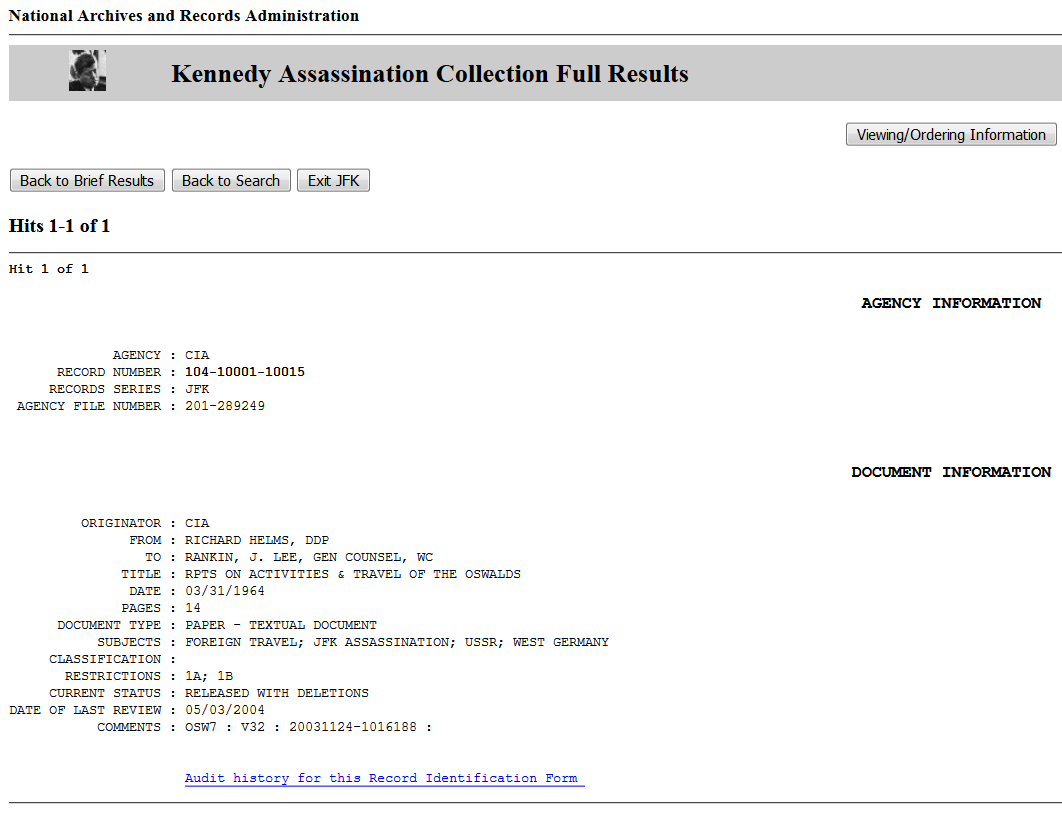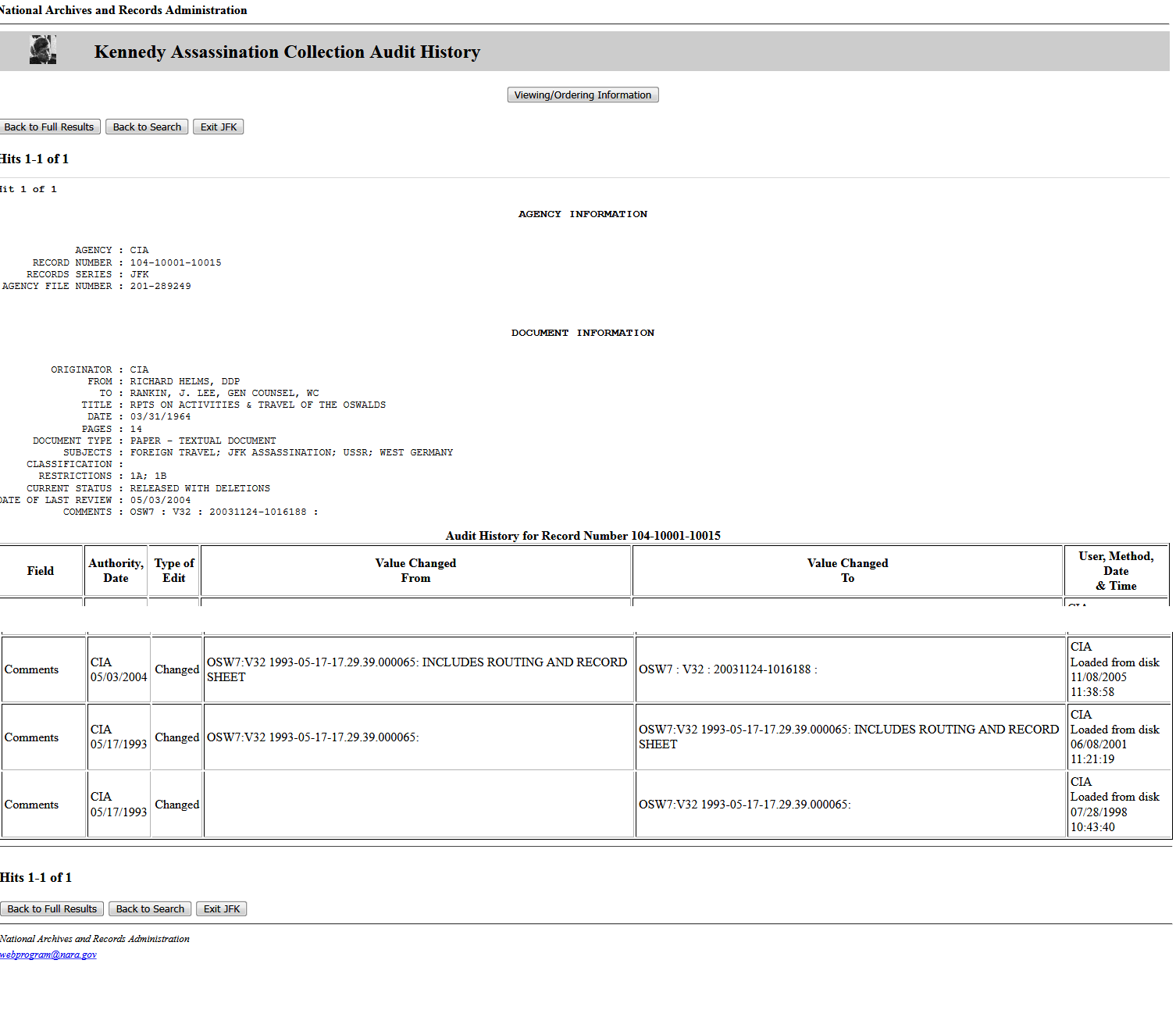Having gone through tons of ARC release trivia, I’m finally looking at what it all adds to our knowledge of the JFK assassination. This post begins with a look at a December 2017 article by Max Holland, who makes many important points on this subject.
Background
The JFK Assassination Records Collection Act of 1992 (ARCA) created the JFK Assassination Records Collection (ARC), now the largest existing archival collection of government documents on the 1963 assassination of President John F. Kennedy and the federal government’s investigation of the assassination. The Collection is stored and administered by the National Archives and Record Administration (NARA).
Many of the records in the ARC were created by federal intelligence and law enforcement agencies, and as such were protected from public release. The ARCA, however, mandated that the vast majority of the Kennedy assassination records would be published in full, and set a deadline of 25 years from the passage of the Act for complete release of all records in the Collection.1
Not content to let the public wait for 25 years to see much of this material, the ARCA also established an indepdent federal agency, the Assassination Record Review Board (ARRB), to begin immediately processing the records for public release, and to seek out additional assassination related materials in both public and private hands. From 1995 to 1998, a large percentage of the restricted materials in the Collection were in fact released in full through the ARRB’s efforts.
When the 25 year limit set by the ARCA was reached on October 26th, 2017, hitherto unreleased materials were in fact made public, amid widespread press coverage. Unfortunately, most of this coverage, including stories in major U.S. newspapers such as the New York Times and Washington Post, was of surprisingly low quality.
The reasons for this almost unrelieved journalistic confusion and error were the subject of Much Ado About Nothing
, an article by Max Holland published in the now defunct news magazine, the Weekly Standard, on December 8, 2017 (available here). Holland, a contributing editor of The Nation magazine, has written extensively not just on the JFK assassination, but on the Cold War era as a whole.
Holland’s work is particularly notable for his effective use of ARC documents, often in areas where they are important and relevant, yet have been ignored or neglected.2 Holland thus offers some of the best-informed commentary available on the ARC, and his article is well worth reading.
Holland on the ARRB review of the ARC
One of Holland’s most important points is how news coverage of the releases either ignored or misunderstood the ARRB’s review of the ARC documents.
Looking back at the news stories of October 2017, this is especially baffling. With the exception of a few local stories in Minnesota interviewing former ARRB chair John Tunheim, who is still serving as Chief Judge in in Minnesota federal district court, I can’t recall a single article that interviewed members or staff of the ARRB.
Holland did not make this mistake. He interviewed Board member William Joyce and ARRB executive director David Marwell. He read the Final Report of the ARRB (and himself testified before the Board in 1995 on the subject of defining an assassination record). He spoke to NARA staff working with the ARC.
The long and short of the story: the ARRB released all assassination information in the ARC documents by 1998. The ARRB only left text redacted when it was deemed to be irrelevant to the facts of the assassination (or fit into one of the VERY narrow exemptions mentioned in footnote 1 below).
This has a rather devastating implication for the news stories which attempted to describe what was new
in the ARC releases.
Cold rice fried again
This Chinese slang for newspaper stories that have passed their best if used by date is an apt description of Holland’s vivisection of the newspaper coverage of the October releases.
Holland’s discussion of ARC document 180-10110-10104 (the “Jenkins memo”) is a fascinating example of the bogus news that arose from the failure to recognize something that had been previously released. This document is a memo of a phone conversation between Johnson’s top aid Walter Jenkins and FBI head J. Edgar Hoover on 11/24/1963, immediately after JFK assassin Oswald had been shot by Dallas club owner Jack Ruby. As Holland notes, this memo featured prominently in testimony before the HSCA3 and was discussed in Holland’s own 2004 book The Kennedy Assassination Tapes (89-90).
The memo was released in part by the HSCA in 1978, and in full by the ARRB in 1998, but in spite of this, NARA released the Jenkins memo with the annotation that it was previously withheld in full. Rather than note the error, newspapers, journalists and commentators cited it as an example of important information withheld for 25 years. One could argue that these people were simply unlucky enough to have missed Holland’s book, but anyone familiar with the HSCA investigation should have spotted NARA’s error.
In this example, the newspaper coverage at least has the excuse that NARA presented the document with inaccurate information, leading those who were not familiar with the HSCA investigation to draw erroneous conclusions. In fact, document after document presented in news coverage of the releases was the same story, without any NARA error to explain why they were writing news articles about decades old material.4
Experts with no expertise
While Holland has harsh things to say about newspaper coverage of the ARC releases in general, his strongest criticism is reserved for people who he thinks ought to know better, professional historians and specialists in the Cold War.
Holland’s criticism of professional historians like Robert Dallek and Michael Beschloss is, I think, well taken. Both men were clearly not familiar with the material in the ARC releases and their comments were substantially uninformed. This was surprising and disappointing: the ARC documents are certainly important for the period they have specialized in, yet Dallek and Beschloss were not able to offer useful or perceptive comment on them.
Nor does Holland spare journalists. He is particularly critical of two reporters: Jefferson Morley and Philip Shenon, whom he compares to two earlier figures who wrote influential works on the JFK assassination: Mark Lane and Edward Epstein.
I have read only a limited amount by Lane, Epstein, Shenon, and Morley, so I should perhaps hold my tongue on the appropriateness of the comparisons. However, it seems to me that it would take extremely dubious behavior to match Lane. While Morley is certainly firmly conspiratorial in his views, I haven’t yet seen anything from him that would put him in the same class with Lane.
I know a little more about Epstein and Shenon, having read both Epstein’s book Inquest and Shenon’s book A Cruel and Shocking Act. These are currently the two primary accounts of the work of the Warren Commission, and Shenon’s book in particular was a disappointment. But again, I’m not sure I see the basis for the comparison between Epstein and Shenon, except that people interviewed by them later had serious complaints about the accuracy of what Epstein and Shenon wrote.
Comparing the flack Epstein took for bad quotes, and the complaints directed against Shenon, it seems Epstein is way up on the non-existent and twisted word scales. On the other hand, some of the Commission staff that Shenon criticizes are dead, and thus have said little to defend themselves.
Future of ARC research
The ARC is surely one of the most important collections for Cold War history available. As Holland says early on in his article, “Dozens of dissertations are waiting to be written based on the records [in the ARC].” Why then have professional historians and academics failed to make effective use of it? Holland does not directly answer this question. The failure of historians and specialists to appreciate its value for areas outside the narrow issue of JFK’s assassination is, however, implicit in Holland’s critique. And even on the narrow issue of the JFK assassination, the quality of research done using the ARC is often low indeed. The lure of appearing a pundit and the interest in making books more saleable are also implicit in Holland’s critique. Overall, it is a depressing picture.
- There were, however, exceptions in the Act for certain types of tax documents, court-sealed documents, federal grand jury materials, and deed restricted material held by the NARA. ↩
- Two fascinating examples are Holland’s article “A Luce Connection: Senator Keating, William Pawley, and the Cuban Missile Crisis.” Journal of Cold War Studies 1, no. 3 (Fall 1999): 139–67, and “Private Sources of U.S. Foreign Policy: William Pawley and the 1954 Coup d’État in Guatemala.” Journal of Cold War Studies 7, no. 4 (Fall 2005): 36–73. ↩
- It is released (in part) at 3 HSCA 468. For testimony regarding the memo, see 3 HSCA 565-569, 714-718, etc. ↩
- See Dale Myers’ great article “Scraping the bottom of the barrel” at his blog JFKFiles for many more ludicrous examples. ↩


